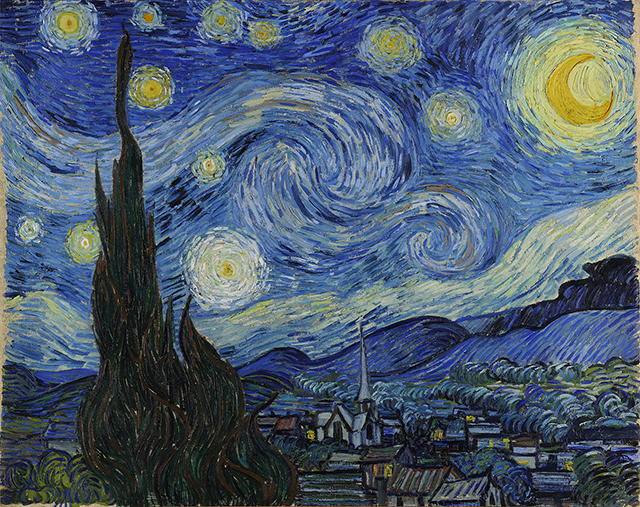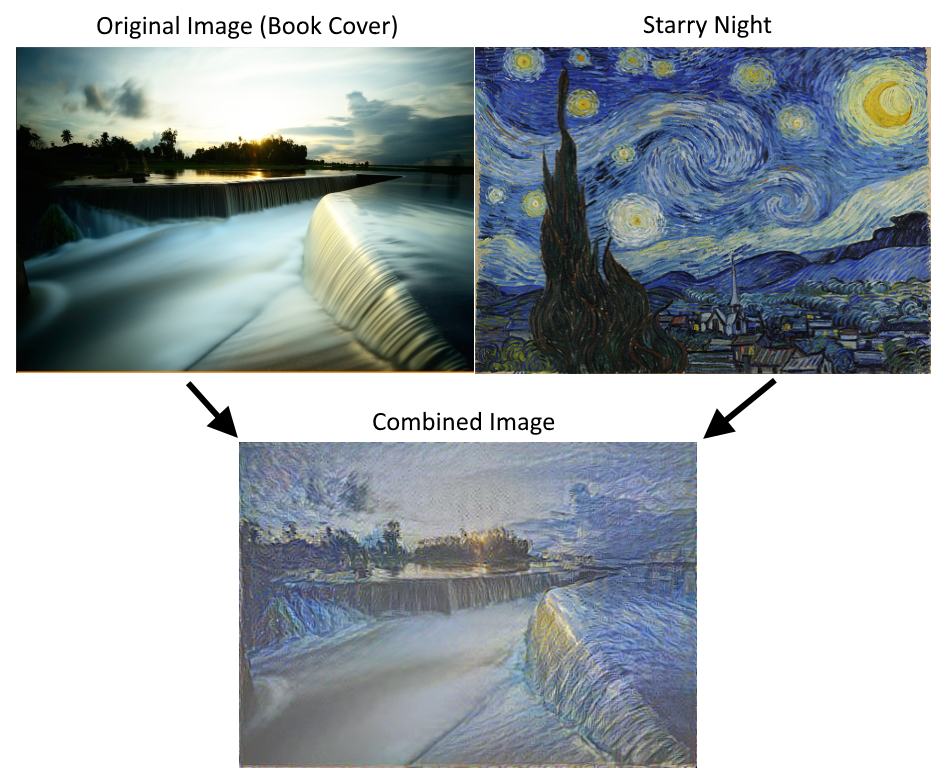Stylenet / Neural-Style
Contents
# Install the necessary dependencies
import os
import sys
!{sys.executable} -m pip install --quiet pandas scikit-learn numpy matplotlib jupyterlab_myst ipython imageio scikit-image requests
# Convolutional Neural Networks
23.9. Stylenet / Neural-Style#
The purpose of this script is to illustrate how to do stylenet in TensorFlow. We reference the following paper for this algorithm.
But there is some prerequisites,
Download the
VGG-verydeep-19.matfile.You must download two images, a style image and a content image for the algorithm to blend.
The style image is

Fig. 23.1 name: Style image starry night#
The context image is below.

Fig. 23.2 name: Content image book cover#
The final result looks like

Fig. 23.3 name: stylenet final result#
We use two images, an original image and a style image and try to make the original image in the style of the style image.
Reference paper:https://arxiv.org/abs/1508.06576
Need to download the model ‘imagenet-vgg-verydee-19.mat’ from: http://www.vlfeat.org/matconvnet/models/beta16/imagenet-vgg-verydeep-19.mat
23.9.1. Code#
23.9.1.1. Import#
import os
import scipy.io
import scipy.misc
import imageio
from skimage.transform import resize
from operator import mul
from functools import reduce
from PIL import Image
import numpy as np
import requests
import tensorflow.compat.v1 as tf
tf.disable_eager_execution() #This is tensorflow 1.x version code. Some of them are not fit tensorflow 2.x.
from tensorflow.python.framework import ops
ops.reset_default_graph()
23.9.1.2. Download data#
# URLs
original_image_url = 'https://static-1300131294.cos.ap-shanghai.myqcloud.com/images/deep-learning/CNN/book_cover.jpg'
style_image_url = 'https://static-1300131294.cos.ap-shanghai.myqcloud.com/images/deep-learning/CNN/starry_night.jpg'
vgg_url = 'https://static-1300131294.cos.ap-shanghai.myqcloud.com/data/deep-learning/cnn/imagenet-vgg-verydeep-19.mat'
# Local directories
data_dir = 'temp'
vgg_dir = os.path.join(data_dir, 'VGG')
if not os.path.exists(vgg_dir):
os.makedirs(vgg_dir)
# Function to download and save a file
def download_file(url, directory):
response = requests.get(url)
filename = url.split('/')[-1]
filepath = os.path.join(directory, filename)
with open(filepath, 'wb') as f:
f.write(response.content)
return filepath
# Download images and VGG Network
original_image_path = download_file(original_image_url, data_dir)
style_image_path = download_file(style_image_url, data_dir)
vgg_path = download_file(vgg_url, vgg_dir)
23.9.1.3. Load data and set default arguments#
# Load images using PIL and convert to NumPy arrays
original_image = Image.open(original_image_path)
style_image = Image.open(style_image_path)
original_image = np.array(original_image)
style_image = np.array(style_image)
# Default Arguments
original_image_weight = 5.0
style_image_weight = 500.0
regularization_weight = 100
learning_rate = 10
generations = 100
output_generations = 25
beta1 = 0.9
beta2 = 0.999
23.9.1.4. Style Transfer Implementation using VGG-19 Network#
Now setting VGG-19.
# Get shape of target and make the style image the same
target_shape = original_image.shape
style_image = resize(style_image, target_shape)
# VGG-19 Layer Setup
# From paper
vgg_layers = ['conv1_1', 'relu1_1',
'conv1_2', 'relu1_2', 'pool1',
'conv2_1', 'relu2_1',
'conv2_2', 'relu2_2', 'pool2',
'conv3_1', 'relu3_1',
'conv3_2', 'relu3_2',
'conv3_3', 'relu3_3',
'conv3_4', 'relu3_4', 'pool3',
'conv4_1', 'relu4_1',
'conv4_2', 'relu4_2',
'conv4_3', 'relu4_3',
'conv4_4', 'relu4_4', 'pool4',
'conv5_1', 'relu5_1',
'conv5_2', 'relu5_2',
'conv5_3', 'relu5_3',
'conv5_4', 'relu5_4']
# Extract weights and matrix means
def extract_net_info(path_to_params):
vgg_data = scipy.io.loadmat(path_to_params)
normalization_matrix = vgg_data['normalization'][0][0][0]
mat_mean = np.mean(normalization_matrix, axis=(0, 1))
network_weights = vgg_data['layers'][0]
return mat_mean, network_weights
# Create the VGG-19 Network
def vgg_network(network_weights, init_image):
network = {}
image = init_image
for i, layer in enumerate(vgg_layers):
if layer[0] == 'c':
weights, bias = network_weights[i][0][0][0][0]
weights = np.transpose(weights, (1, 0, 2, 3))
bias = bias.reshape(-1)
conv_layer = tf.nn.conv2d(image, tf.constant(weights), (1, 1, 1, 1), 'SAME')
image = tf.nn.bias_add(conv_layer, bias)
elif layer[0] == 'r':
image = tf.nn.relu(image)
else: # pooling
image = tf.nn.max_pool(image, (1, 2, 2, 1), (1, 2, 2, 1), 'SAME')
network[layer] = image
return network
Here we define which layers apply to the original or style image and get network parameters.
original_layers = ['relu4_2', 'relu5_2']
style_layers = ['relu1_1', 'relu2_1', 'relu3_1', 'relu4_1', 'relu5_1']
normalization_mean, network_weights = extract_net_info(vgg_path)
shape = (1,) + original_image.shape
style_shape = (1,) + style_image.shape
original_features = {}
style_features = {}
Set style weights.
style_weights = {l: 1./(len(style_layers)) for l in style_layers}
Computer feature layers with original image.
g_original = tf.Graph()
with g_original.as_default(), tf.Session() as sess1:
image = tf.placeholder('float', shape=shape)
vgg_net = vgg_network(network_weights, image)
original_minus_mean = original_image - normalization_mean
original_norm = np.array([original_minus_mean])
for layer in original_layers:
original_features[layer] = vgg_net[layer].eval(feed_dict={image: original_norm})
Get style image network.
g_style = tf.Graph()
with g_style.as_default(), tf.Session() as sess2:
image = tf.placeholder('float', shape=style_shape)
vgg_net = vgg_network(network_weights, image)
style_minus_mean = style_image - normalization_mean
style_norm = np.array([style_minus_mean])
for layer in style_layers:
features = vgg_net[layer].eval(feed_dict={image: style_norm})
features = np.reshape(features, (-1, features.shape[3]))
gram = np.matmul(features.T, features) / features.size
style_features[layer] = gram
Make Combined Image via loss function.
with tf.Graph().as_default():
# Get network parameters
initial = tf.random_normal(shape) * 0.256
init_image = tf.Variable(initial)
vgg_net = vgg_network(network_weights, init_image)
# Loss from Original Image
original_layers_w = {'relu4_2': 0.5, 'relu5_2': 0.5}
original_loss = 0
for o_layer in original_layers:
temp_original_loss = original_layers_w[o_layer] * original_image_weight *\
(2 * tf.nn.l2_loss(vgg_net[o_layer] - original_features[o_layer]))
original_loss += (temp_original_loss / original_features[o_layer].size)
# Loss from Style Image
style_loss = 0
style_losses = []
for style_layer in style_layers:
layer = vgg_net[style_layer]
feats, height, width, channels = [dim if isinstance(dim, int) else dim.value for dim in layer.get_shape()]
size = height * width * channels
features = tf.reshape(layer, (-1, channels))
style_gram_matrix = tf.matmul(tf.transpose(features), features) / size
style_expected = style_features[style_layer]
style_losses.append(style_weights[style_layer] * 2 *
tf.nn.l2_loss(style_gram_matrix - style_expected) /
style_expected.size)
style_loss += style_image_weight * tf.reduce_sum(style_losses)
# To Smooth the results, we add in total variation loss
total_var_x = reduce(mul, init_image[:, 1:, :, :].get_shape().as_list(), 1)
total_var_y = reduce(mul, init_image[:, :, 1:, :].get_shape().as_list(), 1)
first_term = regularization_weight * 2
second_term_numerator = tf.nn.l2_loss(init_image[:, 1:, :, :] - init_image[:, :shape[1]-1, :, :])
second_term = second_term_numerator / total_var_y
third_term = (tf.nn.l2_loss(init_image[:, :, 1:, :] - init_image[:, :, :shape[2]-1, :]) / total_var_x)
total_variation_loss = first_term * (second_term + third_term)
# Combined Loss
loss = original_loss + style_loss + total_variation_loss
# Declare Optimization Algorithm
optimizer = tf.train.AdamOptimizer(learning_rate, beta1, beta2)
train_step = optimizer.minimize(loss)
# Initialize variables and start training
with tf.Session() as sess:
tf.global_variables_initializer().run()
for i in range(generations):
train_step.run()
# Print update and save temporary output
if (i+1) % output_generations == 0:
print('Generation {} out of {}, loss: {}'.format(i + 1, generations,sess.run(loss)))
image_eval = init_image.eval(session=sess)
image_eval = image_eval.reshape(shape[1:]) # Make sure form is right
image_eval += normalization_mean # Add avg
image_eval = np.clip(image_eval, 0, 255) # Make sure value between 0 and 255
image_eval = image_eval.astype(np.uint8) # Transform to uint8
# Save image
output_file = 'temp_output_{}.jpg'.format(i)
imageio.imwrite(output_file, image_eval)
Generation 25 out of 100, loss: 10359594.0
Generation 50 out of 100, loss: 7851741.5
Generation 75 out of 100, loss: 6664776.0
Generation 100 out of 100, loss: 6305506.0
23.9.2. Your turn! 🚀#
You can practice your cnn skills by following the assignment object recognition in images using cnn.
23.9.3. Self study#
You can refer to those YouTube videos for further study:
23.9.4. Acknowledgments#
Thanks to Nick for creating the open-source course tensorflow_cookbook. It inspires the majority of the content in this chapter.


